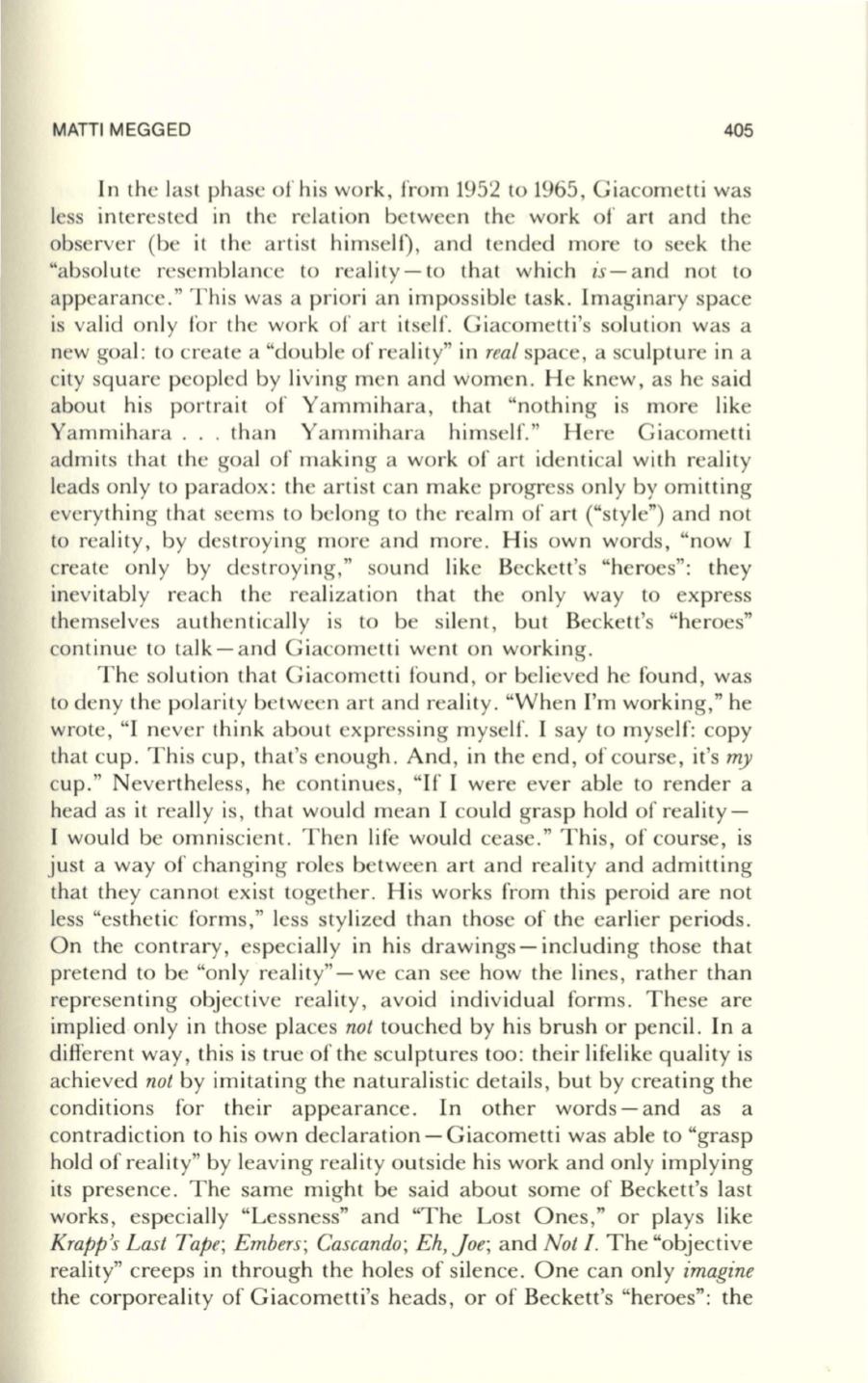
MATTI MEGGED
405
In the las t phase of hi work, from 1952 to 1965, Giacometti was
less in te rested in the relat ion betwee n the work of art a nd the
observe r (be it the a rtist himself), and te nded more to seek the
"absolute resembl ance to reality - to tha t which
is -
and not to
appearance ." T hi s was a priori an imposs ible task . Imagina ry space
is valid onl y lor the work of a rt itself. G iacometti 's solution was a
new goal: to create a "double of reality" in
real
space, a sculpture in a
city squa re peopled by li ving men and women . H e knew, as he said
about hi s portra it of Yammiha ra, tha t "no thing is more like
Yammiha ra ... than Yammihara himsel f. " H ere G iacometti
admits that the goal of making a work of a rt identical with reality
leads onl y to paradox: the a rti st can make progress onl y by omitting
eve rything that seems to belong
to
the realm of art ("s tyle") and not
to reality, by des troy in g mo re a nd more . His own words, "now I
create onl y by des troy ing," sound like Beckett's "heroes": they
inev itabl y reach the reali za tion tha t the onl y way to express
themselves authenticall y is to be sil ent, but Beckett's "heroes"
continue to ta lk- a nd G iacometti went on working .
The solu tion that G iacomet ti fo und , or believed he found , was
to deny the pola rity be twee n a rt and reality. "When I'm working," he
wrote, "I neve r think a bout express in g myself. I say to myse lf: copy
that cup . This cup , th a t's enough . And , in the end , of course, it's
rrry
cup ." Neve rtheless, he continues, "If I were eve r able to render a
head as it reall y is, tha t would mean I could gras p hold of reality –
I would be omni scient. T hen life would cease." This, of course, is
just a way of changing roles betwee n a rt and reali ty and admitting
that they cannot ex ist toge ther . His works from thi s peroid a re not
less "esthetic forms," less styli zed tha n those of the earlier period s.
On the contra ry, es pecia ll y in hi s drawin gs - including those tha t
pretend to be "onl y reality" - we can see how the lines, rather than
representing objec ti ve reality, avo id indi vidual forms. These are
implied onl y in those pl aces
not
touched by hi s brush or pencil. In a
different way, thi s is true of the sculptures too: their lifelike quality is
achieved
not
by imita ting the na tura listi c deta ils, but by creating the
conditions for the ir a ppearance. In other words - and as a
contradicti on to hi s own decla ra tion - Giacometti was able to "gras p
hold of reality" by leav ing reality outside hi s work and onl y implying
its presence. The same mi ght be said about some of Beckett's las t
works, es pecially "Lessness" a nd "The Los t Ones," or plays like
Krapp 's Last T ape; E mbers; Cascando; Eh, J oe;
and
Not I .
The "obj ective
reality" creeps in through the holes of sil ence. One can onl y
imagine
the corporeality of Gi acometti's heads, or of Beckett's "heroes": the


